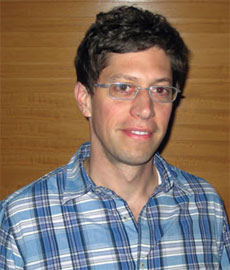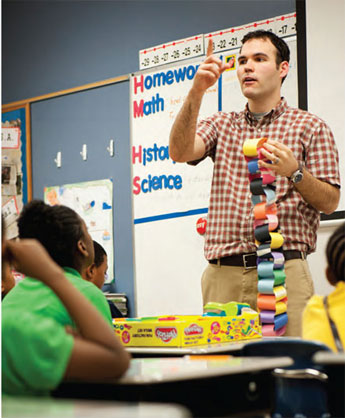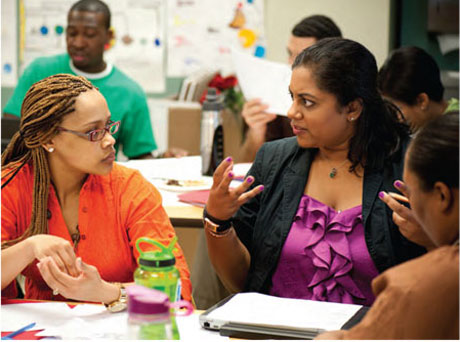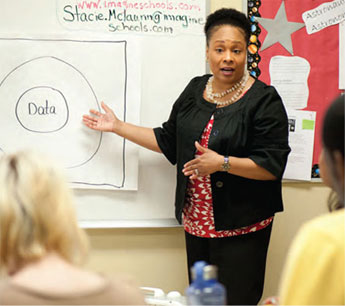The test question showed a carton labeled “15 pencils.” “Sharif sharpened 5 pencils,” the question continued. “Which fractions represent the pencils that Sharif sharpened?”
Fourteen of the 4th graders at Washington, D.C.’s Hope Community Charter School had chosen the right answer—1/3 and 5/15—on a test written for the school by Boston-based Achievement Network (ANet). But 20 chose the wrong answer, and two didn’t answer at all.
So on a bright November afternoon three weeks after the test, Hope’s math specialist, Christine Madison, and two of the school’s 4th-grade teachers huddled over five pages of test-score data assembled for them by ANet. Hope’s Tolson campus serves 420 youngsters in grades PreK–8, almost all of them African American and two-thirds of them from low-income families. It is one of three D.C. charters that are operated by Virginia-based Imagine Schools and are working with ANet. The city’s charter board calls Hope “mid-performing”—about 40 percent of its elementary-school children and 60 percent of its middle schoolers are considered proficient in math and English.

The ANet data showed that the children generally understood fractions. But they also showed that many youngsters—including some with otherwise good scores—were unsteady at fractional models, or word problems, which are among the 15 math standards that Washington schools are expected to teach their 4th graders.
The fraction lesson, drawn from the class textbook, apparently didn’t work when the teachers first taught it. So at this half-day data-analysis exercise scripted by ANet and overseen by an ANet coach, Madison and the teachers debated why it failed and plotted how to reteach it. How about using an art project, fraction charts, flip-books, team competitions, they mused. How about reteaching the lesson to youngsters grouped by ability? How about reteaching boys and girls differently?
Think about how you taught the lesson the first time, and then do something different, urged Madison, who grew more exuberant with each new idea. “I think I may not have used enough visual aids,” one teacher finally conceded as Madison beamed.
Learning Curve

Data-driven instruction began its spread across the country about a decade ago, in the footsteps of the No Child Left Behind requirement that schools administer yearly achievement tests. Those tests didn’t help teachers spot and backfill learning gaps, though. Scores came back after everyone had moved on to the next grade, and anyway, the tests were designed to hold schools accountable for the performance of groups: Did enough English-learners pass, enough African Americans? They were not intended to show which students didn’t understand decimals.
By most accounts, a few charter schools began testing their youngsters more frequently, with the idea that teachers could use those interim results to inform their teaching. “If you pay attention to what students learn and what they don’t, you learn how to teach more effectively,” says Paul Bambrick-Santoyo, whose book Driven by Data is a primer on data-driven instruction.
But on the ground, data-driven instruction has encountered problems. Schools complain that interim assessments produced by publishers aren’t always aligned with curricula, pacing guides, or year-end state tests. The assessments are often too easy, handing schools an unhappy surprise when state test results are posted.
Some districts have taken over the job of producing interim tests, but their data offices have the reputation of taking so long to return results that the information is too old to be of much use. (Ben Fenton of New Leaders for New Schools says he has encountered schools that sidestep their districts by photocopying their kids’ answer sheets and grading the assessments themselves.)
Schools that have tried to develop their own assessments have found the job overwhelming. Jermall Wright, principal of southeast Washington’s Leckie Elementary, told me that his leadership team tried it when they decided that the district’s assessments were inadequate. But writing, scoring, and analyzing the tests took so much time that they quickly abandoned the effort.
In any event, few teacher-education schools include data-analysis training, so many teachers don’t know how to read the data, or don’t have the time to use the information to rethink their lesson plans.
By the mid-2000s, “data was starting to become a hot topic,” says John Maycock, who at the time was completing a master’s degree in the school-leadership program at Harvard’s Graduate School of Education. But “teachers were saying they wanted help” understanding and using it, he adds.
“We started to see that just having access to better data was not enough to drive improvement,” says Joe Siedlecki, a program officer at the Michael and Susan Dell Foundation, which has given $1.7 million to ANet.
Maycock’s solution was to found a nonprofit organization that combines rigorous, standards-aligned assessments; data-analysis training and coaching for school leaders and teachers; guided peer review; and networking across schools. Schools join ANet, pay a fee for its services, and commit their teachers and principals to a four-times-a-year cycle of testing and data review. The model goes beyond traditional professional-development models by linking ANet’s work to each school’s data feedback loop: student achievement results inform the guidance ANet provides.
Coaching the Team

Two days after Hope’s data-analysis meeting, I returned to the charter school to listen as its leadership team reviewed the session with ANet coach Amrutha Nagarajan, a 28-year-old Wellesley- and Harvard-educated former banker. Nagarajan came to Washington as a D.C. Teaching Fellow, resisting pressure from her Indian-immigrant parents to pursue a business career, she says, and now coaches 14 schools for ANet.
Hope had administered its second cycle of interim assessments in math and English-language arts on November 8 and 9 after downloading the tests from ANet’s web site. The untimed tests are given every six to eight weeks and typically take youngsters about an hour, Nagarajan told me. The 4th-grade math test asked 34 questions; the 3rd-grade language-arts test included three readings—a folk tale, a poem, and a nonfiction passage—and 20 questions.
The school’s leadership team had the option to view the year’s assessments well beforehand to be sure the school’s lesson plans and pacing would prepare kids for the district’s year-end tests. Hope doesn’t factor the ANet interim test scores into youngsters’ overall grades, and in their contract with ANet, network schools agree not to use the scores to rate their teachers, a move designed to dampen teacher resistance. School leaders also agree to carve out time for teachers to look at the data together, and to take part in the cycle of meetings and reviews themselves.
After the early-November tests, Hope shipped its completed answer sheets to ANet’s Boston office. Within 48 hours of receiving them, ANet posted the results online, and Hope printed out a set for every teacher. The data tell teachers how their students answered each question, of course, but also how each youngster, the class, and the grade scored on questions aligned to each standard, like dividing whole numbers or identifying details in a reading passage.
The data showed that among Hope’s 5th graders, for example, 88 percent appeared to understand how to find the area and perimeter of rectangles and triangles, but only 26 percent could do the same with circles. Among 8th graders, 65 percent could analyze details and draw conclusions from two reading passages—they did better at nonfiction than fiction—but just 52 percent could identify the author’s main purpose in writing the piece.

ANet’s coaching script next called for Nagarajan and the leadership team to go over the results—in ANet parlance, this is a pre-data meeting—and set priorities for a professional development day, or data meeting, two days later. They agreed that Hope’s 8th-grade language-arts teachers would concentrate on how better to teach “author’s purpose,” a D.C. learning standard. Its 6th-grade teachers would focus on “drawing conclusions,” its 3rd-grade teachers on “analyzing details,” and so on, through each grade and subject.
The idea, Nagarajan told me, is for teachers to “go deep on one or two standards” by dissecting four or five test questions each at the data meeting. The goal, she added, is for that kind of item analysis to become part of each teacher’s routine as she becomes more comfortable with data.
Nagarajan—whose teaching experience includes a year in Chennai, India, after the 2004 Indian Ocean tsunami—remained in the background on data meeting day as Hope’s teachers worked on their reteaching plans. But she and ANet provided a clear structure to keep the school’s improvement plans on track.
During the data meeting, teachers pored over a form called an “item analysis template”—downloaded from the ANet web site—that forced them to think through the test questions that had given their kids the most grief. “What were the misconceptions” that led so many students to choose the wrong answer, the form asked them to consider. What groups of students missed the answer? What did students need to know to get it right?
Next, they worked through a “reteach action plan,” also downloaded from ANet. How was the lesson taught originally, the form asked. How and when would it be retaught, and to whom—the whole class, a small group, individual children?
Nagarajan, meanwhile, pressed Hope’s leadership team to meet deadlines and create what she called “follow-up structures.” When Dr. Chloé Marshall, Hope’s high-energy principal, said her teachers would file their reteaching plans that Friday, Nagarajan asked, “By the end of Friday or the beginning of Friday?” When would they do the reteaching, the next step on the ANet agenda, she asked. Those “reteaches” are supposed to be slipped into a compatible lesson so they don’t derail a teacher’s lesson plans and pacing, and target just those kids who need them.
Nagarajan continued: When would Hope retest—a quick two- or three-question quiz in each class—to make sure the new lesson was effective? When would teachers hold their “reflection meeting,” the last step in the assessment cycle, to look at the new results? “Does that make sense? What do you think?” she pressed the leadership team.
At the postdata-day debrief—more ANet parlance—Nagarajan and the school’s leadership team conceded that the English teachers were still learning how to use the ANet data to break down the broad standards into smaller skills, and to figure out which skills their students were lacking. But they also saw progress: teachers were talking more, sharing strategies, and acknowledging the need to teach differently.
“Some teachers were still challenging the test” by laying the blame on bad questions, Nagarajan said. But many more were “owning the data,” insisted Marshall, making the shift from the-kids-aren’t-learning-it to I’m-not-teaching-it. And with that, the discussion moved on to new teaching strategies, new delivery strategies, resources for new lesson plans, and the team’s goals for Hope’s students.
“The object isn’t to teach kids a process” that leads them to the right answer on a test, “but to visualize a problem and solve it,” Madison said to general agreement. “That’s what will help them in real life.”
Meeting a Need

John Maycock, who is now 37 and calls himself ANet’s “chief growth officer,” had managed afterschool centers in San Francisco, where he says he became “hooked forever” on education. But his real interest was “to be part of something entrepreneurial. I wanted to start something that was an expressed need from the schools,” he adds.
In 2004, Maycock and his mentor, Marci Cornell-Feist, assembled leaders from 10 Boston charter schools around the idea for Achievement Network. Cornell-Feist is the founder of the High Bar, which helps charter boards with management and governance issues.
The Boston charters had begun using interim assessments to prepare their kids for the year-end Massachusetts Comprehensive Assessment System, or MCAS. But the interim tests from outside vendors weren’t as rigorous as, or even aligned with, the MCAS. “They weren’t setting up the school leaders and teachers for success,” Maycock says.
The charters told him they needed better assessments, better data, and help understanding how to use the information, he says. They wanted a common assessment so they could compare results among themselves and use the data to identify best practices. And they wanted assessments that would serve as an instructional tool and not another gotcha mechanism to punish teachers.
Maycock raised $200,000 in seed money from a Massachusetts foundation, but also asked the schools each to pitch in $5,000 “to make it count,” he says. Schools now pay on a sliding scale: those like Hope that are in their first year and need intensive coaching pay $30,000. That declines to $14,000 a year once schools have been in the network for a few years and need less coaching.
Seven charter middle schools signed up with ANet in the 2005–06 school year, its first. Massachusetts had released the MCAS questions for the first time, and Maycock separated them by standard and skill, dissected them for rigor, and wrote his own interim assessments that mirrored the state exam.
James Peyser, a partner in NewSchools Venture Fund, which has invested $1.4 million in ANet and holds a seat on its board, says ANet’s assessments are remarkable for their rigor, which he adds are aimed at readying kids for college, not just for the state tests.
Three Boston district schools joined in ANet’s second year after catching wind of it. Maycock formed a second network of charter schools in Washington in 2008, and nine D.C. district schools joined the next year with help from the Dell grant. There are now 74 schools in the D.C. network.
New Orleans, Newark, Chicago, New York City, and Nashville-Memphis have since launched networks. There’s a network of three virtual schools, and a Baltimore network is planned for 2012. ANet says that 250 schools with some 70,000 kids were members of its networks in the 2011–12 school year. The organization has revenues of $9 million this school year, including $6 million in school fees.
Testing has expanded from the initial grades 6 and 7 to cover grades 3 through 8; ANet is piloting interim assessments for 2nd graders and a set of science tests. High school interims are more complicated because of wider course offerings, but they are “on our radar to consider—very much so,” Maycock says.
In 2010, ANet won a competitive $5 million Investing in Innovation (i3) grant from the U.S. Department of Education, which it is using, in part, to fund a large randomized study of its impact.
In its own analysis, ANet says the number of its youngsters who scored proficient or above on state tests last year increased by 7 percentage points in English and 4 percentage points in math in Chicago, and by 5 points in English and 3 points in math in New Orleans. Of the six cities for which it reported scores last year, ANet said four made twice the gains in English as the rest of their respective states, and three made double the state gains in math.
In D.C., about 6,600 youngsters in ANet’s charter and district schools took year-end tests in 2011. ANet says those scoring proficient in English increased by 4.5 percent and in math by 9 percent from the year earlier. That translates into 319 more kids passing the language exam and 662 more passing math, numbers Maycock calls “huge.” In just the D.C. district ANet schools, the increases were smaller—4 percent in English and 6.6 percent in math—but still better than the improvement of less than 2 percent posted by district schools that didn’t partner with ANet.
Network Strength

The schools in ANet’s original network were a lot alike: urban with high-need populations. Maycock has recently convinced stronger schools to join each network; in D.C., Janney and Horace Mann Elementary Schools, which are among the district’s highest-performing, white-majority schools, joined a network that is generally minority and struggling. The idea is to get charters and district schools, and stronger and weaker schools—schools that don’t generally cross paths—to share ideas and goad each other to improve.
Network schools have access to each other’s grade-level data, they share ANet coaches, and they’re invited to regular “learning walks,” where one network school models a practice for other network members.
A few days after the data-day review, I visited Powell Elementary, a district school in northeast D.C., for a learning walk on peer-group feedback, or how to get teachers to help one another figure out how to reteach a troublesome lesson. Teachers, data and instructional coaches, and a principal from eight widely different schools attended.
The practice Powell was showing off involved having its teachers present their reteaching plans—developed on data day—to a handful of teachers from other grades and specialties. These “critical friends” ask “clarifying questions” about the plan, and then talk it over among themselves. The presenting teachers can take or leave the suggestions without having to defend their lesson plans.
As I listened, a Powell math teacher modeled the process while the visitors leaned in close and tossed out their own ideas. Consider a math competition, said the dean of an all-boys, entirely African American charter school that seemed to have little in common with Powell: “Kids respond well to that.” Identify the 10 words most commonly used in word problems, said a math specialist from a district school that seemed to mirror Powell’s English-learner enrollment.
“I hadn’t thought about using manipulatives” in the lesson, conceded the Powell teacher as the ideas rolled in—and his kids would benefit from a hands-on lesson that burned up some of their energy, he added. After two hours, with the learning walk long ended, a dozen teachers from around the network were still huddled together, still talking lesson plans.
Powell keeps an ANet data wall in its front lobby and records how many youngsters in each class score proficient or advanced in math and in language arts for each ANet assessment cycle. Powell’s parents attend a data meeting when the results come out each cycle, and “all but three or four” regularly attend, principal Janeece Docal told me.
Powell’s highly public use of the data contrasts with that of Hyde-Addison Elementary, a third-year ANet school in D.C.’s swank Georgetown neighborhood, which uses the ANet data only internally. “We see what you know and what you don’t know. We see what we’ve taught you,” principal Dana Nerenberg told me.
Powell links the data discussion to the kids’ future, Docal explained: good ANet scores translate into good scores on the year-end test, which will land the youngsters in the high school and then the college and then the job of their choice. “Education equals freedom,” she said a dozen times over the afternoon.
How schools use the data “depends on the school’s culture,” says Justin Jones, a former Teach For America corps member and recruiter who heads the D.C. network.
Peyser, at NewSchools Venture Fund, says the goal is to help “change and strengthen school culture toward data” until “it becomes the way they do business.”
June Kronholz is an Education Next contributing editor.
This article appeared in the Summer 2012 issue of Education Next. Suggested citation format:
Kronholz, J. (2012). Teaching the Teachers: Achievement Network offers support for data-driven instruction. Education Next, 12(3), 8-15.


